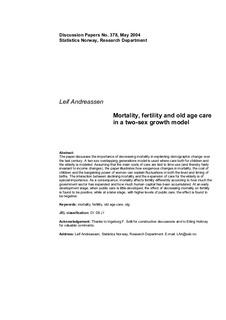| dc.contributor.author | Andreassen, Leif | |
| dc.date.accessioned | 2011-11-23T17:57:35Z | |
| dc.date.available | 2011-11-23T17:57:35Z | |
| dc.date.issued | 2004 | |
| dc.identifier.issn | 1892-753x | |
| dc.identifier.uri | http://hdl.handle.net/11250/180439 | |
| dc.description.abstract | Abstract:
The paper discusses the importance of decreasing mortality in explaining demographic change over
the last century. A two-sex overlapping generations model is used where care both for children and
the elderly is modeled. Assuming that the main costs of care are tied to time use (and thereby fairly
invariant to income changes), the paper illustrates how exogenous changes in mortality, the cost of
children and the bargaining power of women can explain fluctuations in both the level and timing of
births. The interaction between declining mortality and the expansion of care for the elderly is of
special importance. As a consequence, mortality affects fertility differently according to how much the
government sector has expanded and how much human capital has been accumulated. At an early
development stage, when public care is little developed, the effect of decreasing mortality on fertility
is found to be positive, while at a later stage, with higher levels of public care, the effect is found to
be negative. | no_NO |
| dc.language.iso | eng | no_NO |
| dc.publisher | Statistics Norway, Research Department | no_NO |
| dc.relation.ispartofseries | Discussion Papers;No. 378 | |
| dc.subject | Mortality | no_NO |
| dc.subject | Fertility | no_NO |
| dc.subject | Old age care | no_NO |
| dc.subject | JEL classification: D1 | no_NO |
| dc.subject | JEL classification: D9 | no_NO |
| dc.subject | JEL classification: J1 | no_NO |
| dc.title | Mortality, fertility and old age care in a two-sex growth model | no_NO |
| dc.type | Working paper | no_NO |
| dc.subject.nsi | VDP::Social science: 200::Economics: 210::Economics: 212 | no_NO |
| dc.subject.nsi | VDP::Social science: 200::Demography: 300 | no_NO |
| dc.source.pagenumber | 36 s. | no_NO |
